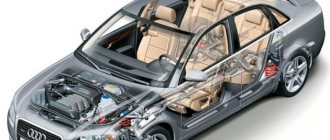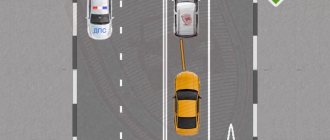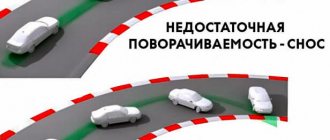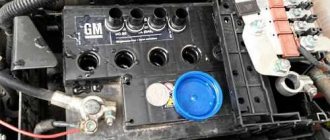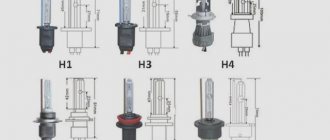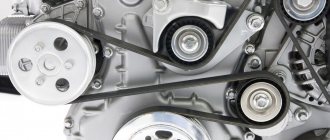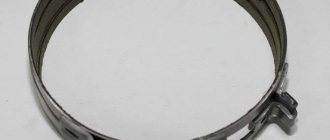Using a rigid structure to tow a broken vehicle is called a rigid hitch. This is a convenient and safe way to move your vehicle. But it must be carried out in compliance with the conditions specified in the traffic rules, otherwise you will have to pay a fine or eliminate the consequences of the accident.
Read about how a rigid hitch should be used, as well as methods for making the device yourself, in this article.
In this article:
Features of a rigid coupling
This method of towing is carried out using a solid structure, one end of which is attached to the driving vehicle, the other to the driven one. It allows both vehicles to be kept on the same line while driving, which ensures reliability and safety.
Therefore, a rigid vehicle coupling is especially useful for moving heavy, clumsy equipment. It will prevent cars from colliding with each other.
Rigid hitch: dimensions and distance when towing trucks and cars
The most difficult moment is the beginning of towing, that is, the start. The driver of the vehicle that will be transported must make sure that the handbrake is released and the gear is engaged. All subsequent actions belong to the driver of the tractor. He should start moving in the lowest gear. The vehicle must move slowly and smoothly to pull the towed vehicle without jerking. Another important point is changing gears while moving. This needs to be done as quickly as possible. The towed vehicle's hazard warning lights must be on while traveling along the route. If it doesn't work, there should be a warning triangle attached to the back of the car. If a truck is to be transported, then it is necessary to evaluate its tonnage and the weight of the cargo, if any. The tractor must be able to tow the vehicle without strain or overheating. That is, its weight must exceed the weight of the other car. A rigid truck hitch must also be compatible with the overall weight of the vehicle being towed. The driver of the tractor should check the belt tension and coolant level, because increased loads are expected, and the engine must be cooled efficiently. The driver of the car that will be towed also needs to prepare: disconnect the low voltage wire on the ignition coil. Immediately before setting off, both drivers need to coordinate their actions.
Please note => Land tax benefits for budgetary organizations
When may be required for transportation, towing
The method is applicable to moving domestic or imported cars. It can be used at night, regardless of the season. Towing with a rigid hitch can be carried out outside the city and within its boundaries. Fog is also not a hindrance for her.
Another advantage of this method over a flexible coupling is that it can be used to move a car with a faulty brake system. The device will prevent him from hitting the leading car from behind. But at the same time, the weight of the towed car should not exceed half of the same figure as the towing vehicle.
Basic rules governing the operation of a rigid hitch
All trailers without exception must have a rigid coupling option with the towing vehicle. The use of soft options is only available if the towed car has a working brake and steering system. All these features are enshrined in the traffic rules. If you come up with the opportunity to transport a trailer on a soft hitch, you will receive a good fine at the next traffic police station. Also, a rigid hitch is used in cases where the towed vehicle has a malfunction in the braking system or steering; operation and towing on a soft rope can be dangerous. The main features of safe towing with a rigid hitch are as follows:
- the towed car does not have a chance to drive into the tow, since the rigid coupling provides a certain distance;
- the hitch bar itself (it can be single or double) must be painted in a bright color or marked with signal flags;
- towing with such a stretch ensures that the towed vehicle is given the direction of movement of the tow;
- the illumination rules remain the same - the front car turns on the low beam headlights, and the rear one turns on the hazard warning lights;
- towing is possible at speeds of up to 50 kilometers per hour, if we are talking about two cars;
- in fact, you should not exceed the speed limit within 40 kilometers per hour - it turns out to be safer.
There are also many subtleties that relate to commercial vehicles or cars damaged in different versions. The best conclusion to draw is this: if you are going to tow a car damaged in an accident, you should use a rigid hitch. This will help you avoid potential problems and give you a better chance of getting to your destination safely. It is important to use only confident speed limits and avoid sudden movements both in the tow vehicle and in the driven vehicle. To understand the nature of towing, we should talk about the functional side of the issue.
Is a category necessary?
The driver of a car that is pulling another vehicle on an inflexible device must be quite experienced. But one of the issues that worries motorists in connection with the concept of “rigid coupling” is the category of rights. Some people think that they should be with the letter E, allowing them to carry a trailer heavier than 750 kg.
More on AutoLex.Net:
Everything that should be in a car's first aid kit
The definition of the difference between it and a car is in the traffic rules:
“Trailer” is a vehicle that is not equipped with an engine and is intended to be driven in conjunction with a power-driven vehicle.
A motor vehicle is a vehicle driven by an engine. the term also applies to any tractors and self-propelled machines.
Towing of cars is regulated by paragraph 20 of the traffic rules. It does not specify categories of rights. They are discussed in Article 25 of the Law “On Road Safety”. The legal document establishes a special category for each vehicle, as well as for the use of trailers with them. There is no mention of towing here.
It is clear from the traffic rules that a trailer and a car that has lost the ability to move under its own power are different types of vehicles. The law that exists for the use of the former does not apply to the latter. And in order to tow a car, the driver does not need to have the letter E on his license.
Government Decree No. 333 of March 24, 2017 contains a clarification regarding the length of service of a motorist:
When towing, driving towing vehicles must be carried out by drivers who have been licensed to drive vehicles for 2 years or more.
Preparing to tow a vehicle
Let's consider the algorithm of actions when preparing for towing.
- You need to estimate the weight of the car . The tractor must be heavier than the vehicle that needs to be pulled.
- The rigid mount must be suitable for the mounting and load-carrying capacity of the towed vehicle.
- The tow truck driver needs to check the tension of the belts and the presence of coolant . During transportation, if there is not enough fluid, the engine may overheat.
- Before transportation, drivers need to agree on signals with which they will communicate the necessary information to each other.
- The driver of the tractor must have a good rear view, which will allow him to control the transmitted signals.
Transporting a vehicle on a rigid hitch
The most difficult moment is the start of towing:
- The driver of a vehicle that is towing must make sure that the car has the handbrake off and check that the gear is engaged.
- The driver of the tractor should start moving in low gear.
- The vehicle must be driven slowly and the tow must be pulled without jerking.
- Before changing gear, you need to pick up speed as long as possible.
- Gear changes should occur at the highest possible speed. This will minimize the loss in speeds.
- The tractor engine must operate at high speeds.
- On a towed vehicle, the hazard warning lights must be turned on. If it is faulty, you will need to attach an emergency sign to the trunk.
- It is necessary to slowly and smoothly change lanes and brake . You should definitely make sure that two cars can pass under certain conditions, for example, under a traffic light.
- During transportation, the load on the engine increases . Therefore, it is necessary to constantly monitor the coolant temperature.
- Basically, in cars, the braking system and steering control are connected to the operation of the engine . They will not work when the engine is turned off. Because of this, you will need to apply the brakes much harder to brake and will require more effort to turn.
Features of towing a car with an automatic transmission
The rules for passenger cars also apply to cars with an automatic transmission. But it has its own characteristics and rules.
Let's consider almost identical situations:
- A car with an automatic transmission steps in as a tractor and pulls another car.
- The vehicle is pulled by a car with an automatic transmission.
- Difficulties in towing a car with an automatic transmission occur due to the operating principle. When the engine is not running, the oil pump does not function, but the automatic transmission structure works. There is heating, but no cooling.
A car with automatic transmission is used in a narrow range of loads. These characteristics need to be taken into account if you plan to tow a car with an automatic transmission.
Towing an automatic car
The vehicle owner's manual specifies the method by which a broken vehicle is permitted to be transported. If the manual states that transportation is only possible using a tow truck, then this method should be used.
If you still decide to tow a vehicle using a hitch, then the algorithm of actions is as follows:
- It is necessary to check the transmission fluid in the box.
- Unlock the steering, this can be done by turning the ignition key.
- Place the gearbox shift lever in the neutral position.
- The speed should not be higher than 50 km/h, and the distance should not be more than 50 km.
- It is necessary to control the heating of the transmission fluid if you need to stop to cool it.
If you need to transport it over a longer distance, you need to call a tow truck.
Rules for cars and trucks
The method of transporting a car using a rigid structure must comply with certain conditions. They vary slightly depending on the type of vehicle being moved.
Are common
Rigid coupling makes the following rules mandatory:
- the driver must sit behind the wheel of the driven vehicle, except in cases where the device gives him the opportunity to drive along the trajectory of the leading vehicle when moving in a straight line;
- if a bus or trolleybus is towed, no passengers are left in it;
- when moving the truck, there should also be no people in the back;
- a rigid hitch for passenger cars is also used when there are passengers in the cabin;
- vehicle speed cannot be higher than 50 km/h;
- the structure itself must be brightly colored so that other road users can see it and not try to wedge themselves between the leading and driven vehicles;
- The vehicle being towed must have its hazard lights turned on or a sign posted.
More on AutoLex.Net:
Which anti-theft device is relevant for a car?
If the car's steering does not work, this method cannot be used. And in case of damaged brakes, a rigid structure is allowed for use. But the mass of the towed vehicle must be less than the driving one. You can only drag one car, no more.
Distance
The distance between the towed person and the tow vehicle should be sufficient, but not too large. The distance on a rigid coupling is allowed up to 4 m. This is what makes movement safe. The driver of the leading car can see the road from the sides and behind in the mirrors. The one who sits behind the wheel of the follower retains the opportunity to stop in time and not collide with the vehicle in front. The road train does not block the road.
Length
The size of the device is selected in accordance with the requirement for the distance between vehicles. Since it cannot be more than 4 m, the length of the rigid coupling must also be less than this value. The total size of the base of the structure and the fastenings with which it clings to cars are taken into account.
Driver behavior
The traffic rules do not contain nuances that are necessary for successful towing. But experienced motorists know and use them:
- the route is chosen in advance;
- it should not have many problem areas (intersections, U-turns, highways, etc.);
- if it is a rigid hitch for trucks, it is better to drive at a speed of up to 40 km/h;
- you need to agree in advance what signals to communicate on the road if you need to stop and take other actions;
- no need to make sharp turns with the steering wheel;
- movement and maneuvers must be performed smoothly, especially acceleration and braking;
- It’s better not to use backward driving, and if you can’t do without it, then do it in concert.
It should also be taken into account that a rigid hitch is undesirable when you need to pull a car with an automatic gearbox. The equipment may develop additional malfunctions during the process. The likelihood of damage is even higher when using a car with an automatic transmission as a tow vehicle.
More on AutoLex.Net:
Instructions on how to properly attach a child car seat
To learn how to properly tow a vehicle with a rigid hitch, watch this video:
How to tow a car correctly
Universal rigid hitch
Is it possible to tow another car with an automatic transmission? You can read here
Towing with a rigid hitch, so to speak, is more comfortable than with a cable - there are no jerks that occur when it sags. But in both cases, it is necessary to observe moderation when driving a “tractor”. First of all, the driver of the “tractor” must take into account that the load on his car increases significantly. Therefore, in order to avoid overloading the engine and transmission, you should not drive in sport mode, that is, you need to avoid sudden accelerations, and generally maneuver as carefully as possible. Even if the fixed length of the rigid hitch will save you from being hit from behind by the towed car during sudden braking, then if you do not take into account the increased weight of the car with the trailer, you risk “catching up” with the car stopped in front. The recommended speed limit when towing is no more than 50 km/h, but in case of unfavorable road conditions, you can reduce the speed. When towing cars with automatic transmission or such vehicles, it is generally better not to exceed 30 km/h, and on long trips, take breaks to cool the transmission oil and gearbox parts. It is advisable to transport all-wheel drive cars with automatic transmission on a tow truck.
Preparing a rigid coupling with your own hands
For towing, you can buy a factory design. But a do-it-yourself rigid hitch is also quite accessible and can be used. There are two adaptation options:
- In the form of a barbell. It must be foldable, so you need to take 3 pieces of 20 - 50 mm metal pipe, connect them with bolts and hinges. The ends that attach to cars require heads with brackets and fasteners. Bolts can also play the role of the latter.
- In the form of a triangle. Its corners are also fastened with hinges so that the product folds. Those located at the base are designed for a towed car. The top will be attached to the tractor; here you need a fastening, like for a towbar. This is a more durable design, unlike a barbell. With its help, you can move the vehicle over a fairly large distance.
Transportation on a rigid hitch in Russia is not as common as on a flexible device. But in other countries it is used more actively, which proves the effectiveness and safety of the method. Moreover, a static design can help out where a flexible one is contraindicated.
When is it not a good idea to tow with a rigid hitch?
It is better to tow cars that weigh more than the tow itself using a soft hitch. Of course, it is better to abandon such a process altogether, but if the situation has no other solutions, use a soft cable. This way, the braking system of a large car will work on its own, and in the case of a rigid coupling, you will have to endure constant pushes in the back, which can end disastrously for the towing car. There are also a number of other situations in which it is better to refuse towing with a rigid hitch:
- the driver of the towed vehicle does not have enough experience in driving;
- the car is severely damaged, the wheel alignment angles and other important criteria are visually violated;
- the car is too large and heavy, it can simply ruin the tug’s braking system;
- The towing vehicle has an automatic transmission, there is no possibility of adjusting the clutch;
- there is no way to properly engage the elements of the rigid coupling; there is a risk of them falling off along the route.
It is up to the driver to decide whether to use a rigid hitch or any other towing methods to assist the owner of another vehicle. If this may cause certain difficulties or problems in your car, it is better to refuse and try to solve the situation in other ways. In particular, the best option in such a situation is to call a tow truck and transport the damaged or faulty car in the right direction. A rigid hitch is a rather interesting acquisition, but in some situations the cable turns out to be more practical and used in the life of the driver. This is what happens when a rigid hitch is used incorrectly:
What types of rigid couplings are there for cars?
The price of rigid hitches for passenger cars varies depending on the type, the weight capacity of the vehicle being towed, and the diameter of the tow hooks or eyes. The cost of the rods is in the range of 2000-2500 rubles, the “triangle” type device is in the range of 4000-4500 rubles. This is an affordable towing aid that requires no prior training to use and is suitable for vehicles with vertical and horizontal lugs. For manufacturing, an all-metal pipe is used, the parameters of which meet the technical requirements.
What is a rigid hitch for passenger cars?
There is poor visibility Fog, heavy precipitation Slippery road surface Ice, etc. Absent for some reason A working braking system There is heavy traffic - Lack of sufficient experience Drivers of one or both vehicles (towing and towed) There is no second driver to control the towed vehicle vehicle Provides a constant, unchangeable distance between two vehicles Various types of jerks are completely eliminated Or the approach between two cars - which makes a collision simply impossible; There is a quick start of traffic Optimal use in heavy traffic It is possible to avoid jolts in traffic jams - which is especially important for use in the “city” mode The driver does not need extensive towing experience to use this type of hitch
21 Dec 2021 marketur 615
Share this post
- Related Posts
- Are military pensioners entitled to free travel in the Moscow region?
- Is it possible to register a child with a doctor through government services?
- Is a disability pension included in the cost of living?
- What are the requirements for applying for a pension for men born in 1960?
